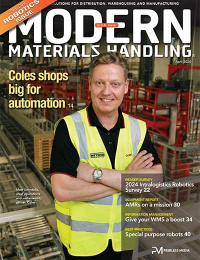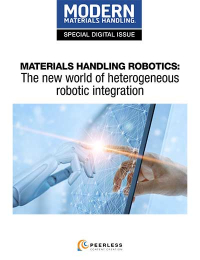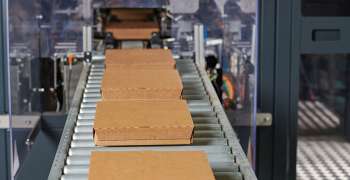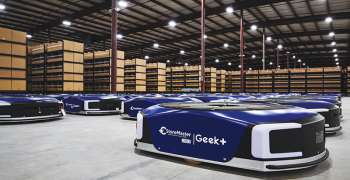Autonomous mobile robot provider MiR marks its 10th anniversary
Founded in Denmark in 2013 and now part of Teradyne, MiR currently employs more than 420 people globally

Less than a decade ago, the idea of fully autonomous mobile robots (AMRs) interacting seamlessly with human employees in warehouses and production facilities seemed a futuristic vision, according to AMR provider Mobile Industrial Robots (MiR). Today, said MiR, which recently celebrated its 10th anniversary, thousands of its AMRs deliver parts, transport finished products, and handle multiple other logistics tasks without the need for human operators, separate work areas, or external guidance.
This is only the beginning of what is projected to be multi-decade growth, with analysts expecting the AMR market to have double-digit growth every year through at least 2027, MiR added.
“MiR was one of the early movers in the AMR industry and was visionary in developing a scalable platform of robots that could be easily deployed and integrated into factories and warehouses,” said Ash Sharma, managing director at Interact Analysis. “It continues to innovate and has helped the industry to grow from a fledgling industry to what is now, a multi-billion-dollar sector with AMRs deployed in thousands of buildings around the world.”
MiR President Jean-Pierre Hathout sees customers now transitioning from using AMRs in pilots to using AMRs 24x7 in production applications. “In the first 10 years of MiR’s history, we led the industry with innovative AMRs as we scaled globally with our customers,” Hathout said. “I couldn’t be more excited about the next 10 years as we build on that innovation to provide a full range of AMR solutions on common software for our global customers. MiR has the proven products, the experience and support structure to help our customers scale; and as a part of Teradyne, we are a trusted long-term supplier for mission-critical production applications.”
MiR has single customers with more than 200 AMRs throughout different sites, while some customers have almost 100 mobile robots in use at single sites, according to the company, which was founded in Denmark in 2013. Today, it has become common to see customers with 30-50 MiR robots in use at a single site.
In May 2013, MiR founder Niels Jul Jacobsen set out to revolutionize the way companies handle their internal logistics, MiR noted. Thomas Visti joined him in late 2014. Both had extensive experience from another successful robotics company, Universal Robots.
In the early years, Visti was on the road with a MiR100 robot in the back of his car, giving demos to distribution partners and prospective customers. From the very beginning, however, MiR focused on a global market approach based on sales and service via distributors and a focused product range. Today, MiR robots are sold by more than 220 distributors and certified system integrators in 60 countries. In addition to its headquarters in Odense, Denmark, MiR has regional offices in Boston; Holbrook, New York; San Diego; Chelmsford, Massachusetts; Georgetown, Kentucky; Singapore; Frankfurt; Barcelona; Yokohama; Seoul, and Shanghai.
In April 2018, US-based Teradyne, Inc. acquired MiR, further accelerating the company’s position as a global market leader and providing the financial strength and stability for sustained growth, MiR added. From just three employees at the start of 2015, MiR currently employs more than 420 people globally, with an annual turnover of $77 million (USD) in 2022.
Large multinational companies, including Toyota, Ikea, Novo Nordisk, Denso, DHL and Schneider Electric, account for a majority of MiR’s sales. A merger with AutoGuide Mobile Robots in 2022 added high payload AMRs, furthering MiR's strategy of being a trusted supplier of a full range of AMRs to our global customers, the company added.
In addition to continuously developing new AMR models, MiR recently launched a new cloud-based software tool that enables fleet owners to manage and optimize the operations of its robots by gaining actionable insights to improve the robots’ deployment.
“As robot fleets grow, so does the demand for software tools to optimize performance and manage full fleets,” Hathout added. “If we want AMRs to be as common as forklifts and pallet lifters, it is essential that we lower the barriers for implementation, reprogramming and maintenance. We have already made substantial progress in this direction, and I firmly believe we have only glimpsed the true potential of automated logistic solutions.”

Article Topics
Mobile Industrial Robots News & Resources
Autonomous mobile robot provider MiR marks its 10th anniversary MiR appoints new president, extends strategy for global growth Modula and MiR collaborate on fully autonomous storage, picking MiR’s autonomous mobile robot sales up 42% in 2021 MiR and Logitrans enter collaboration to build autonomous pallet jacks MiR sees 55% increase in AMR sales for Q1 2021 Mobile Industrial Robots presents expanded AMR fleet More Mobile Industrial RobotsLatest in Materials Handling
Registration open for Pack Expo International 2024 Walmart chooses Swisslog AS/RS and software for third milk processing facility NetLogistik partners with Vuzix subsidiary Moviynt to offer mobility solutions for warehouses Materials Handling Robotics: The new world of heterogeneous robotic integration BSLBATT is looking for new distributors and resellers worldwide Lucas Watson appointed CSO for Körber’s Parcel Logistics business in North America Hyster recognizes Dealers of Distinction for 2023 More Materials HandlingSubscribe to Materials Handling Magazine

Find out what the world's most innovative companies are doing to improve productivity in their plants and distribution centers.
Start your FREE subscription today.
April 2024 Modern Materials Handling

Latest Resources










